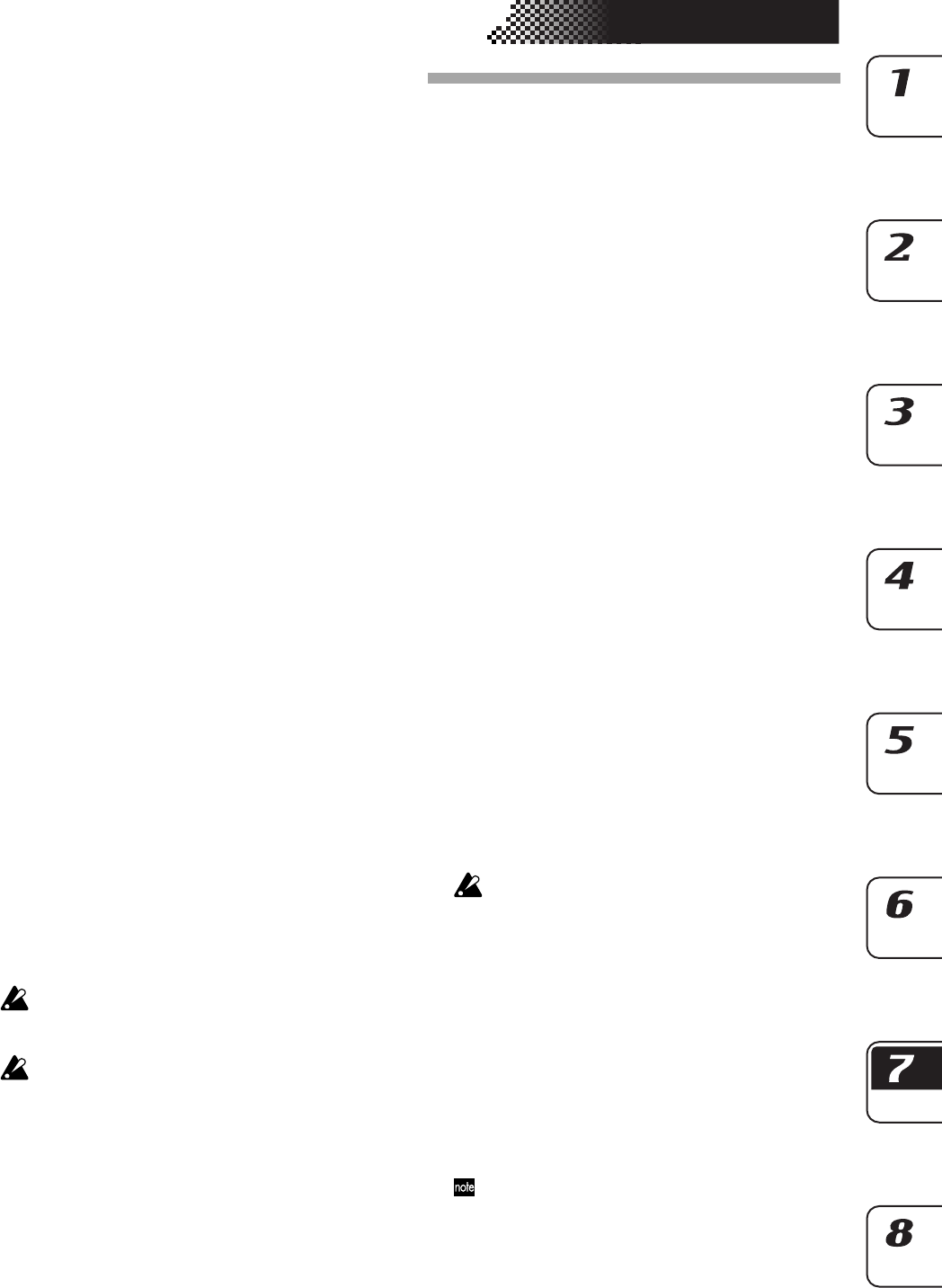
95
7. Global mode
About synchronization in Song
mode
In Song mode, the ESX-1 will also transmit Song Select and
Song Position Pointer messages.
Song Select
When you switch songs, a Song Select message [F3,
ss] (ss: song number) will be transmitted. On the
ESX-1 you can select 64 songs. If the ESX-1 receives
a Song Select message when in Song mode, it will
switch songs.
You can use the Global mode MIDI Filter settings
to enable/disable transmission and reception of
Song Select messages.
Song Position Pointer
If you change the song position of the master de-
vice (clock set to “Int”) while the song is stopped,
it will transmit a Song Position Pointer message [F2,
pp, pp] (pp, pp: lower and upper bytes of the value;
pp: the number of MIDI beats from the beginning
(number of timing clocks / 6)).
The Song Position Pointer message indicates the
location at which the sequencer is currently
stopped. If the slave (clock set to “Ext” or “Auto”)
receives a Song Position Pointer message in Song
mode, it will change its own current location (i.e.,
the location at which its currently selected song is
stopped) to the same location as the master.
On the ESX-1 however, the length will differ for
each pattern, so the master and slave will not nec-
essary be located at the same position.
If you change the position on the master device to
make it transmit a Song Position Pointer message,
and then press its START/PAUSE key, a Continue
message (or a Start message if the position is 001)
will be transmitted, and the song will begin play-
ing.
If a slave receives a Continue message, it will be-
gin playback (in synchronization to the incoming
Timing Clock) from the position indicated by the
Song Position Pointer message it received. This lets
you playback in synchronization from the desired
location in the song, just as when playing back in
synchronization from the beginning.
Song Position Pointer messages are not transmit-
ted when you use the dial or the select keys to fast-
forward or rewind during playback.
Be aware that if you perform such operations dur-
ing synchronized playback, synchronization will be
lost. Also, the playback location will not change if a
Song Position Pointer message is received during
playback.
Editing sounds
By using MIDI exclusive data dumps you can edit all pat-
terns or one pattern at a time. You can also use NRPN
messages to edit the knobs that are valid for each part.
Editing via NRPN
NRPN (Non-Registered Parameter Number) messages are
a type of message that can be freely used by any manufac-
turer to control the assigned parameter number. On the ESX-
1, you can use control change messages to edit keyboard
part parameters or effect section parameters, but NRPN mes-
sages are assigned to the drum parts.
To edit a drum part parameter, use NRPN (LSB) [Bn, 62, rr]
and NRPN (MSB) [Bn, 63, mm] (control change #98 and 99)
(rr, mm: lower and upper bytes of the parameter number)
to select the desired parameter. Then use data entry (MSB)
[Bn, 06, mm] and data entry (LSB) [Bn, 26, vv] (control change
#6 and 38) (mm, vv: upper and lower bytes of the value,
together expressing a range of 16,384 steps) to set the value.
About system exclusive
messages
Since the way in which system exclusive messages are used
is left completely up to the manufacturer, these messages are
used mainly to transmit or receive sound parameters or editing
data that is specific to a particular device. The ESX-1’s sys-
tem exclusive message format is [F0, 42, 3n, 71, ff, ... F7].
F0: exclusive status
42: Korg ID
3n: [n=0~F] global MIDI channel 1~16
71: the ESX-1’s model ID
ff: function ID (type of message)
...
F7: end of exclusive
Some USB-MIDI interfaces are unable to transmit
or receive the ESX-1’s MIDI exclusive messages.
Universal system exclusive messages
There is a special category of system exclusive mes-
sage whose uses are publicly defined. These are
called Universal System Exclusive messages.
The ESX-1 implements the following Universal Sys-
tem Exclusive messages.
—Inquiry Message Request [F0, 7E, nn, 06, 01, F7]
—Inquiry Message [F7, 7E, nn, 06, 02, (9 bytes), F7]
When the ESX-1 receives an Inquiry Message Re-
quest, it will respond by transmitting an Inquiry
Message with the meaning of ‘I am a Korg ESX-1
with system version ...’
If you wish to obtain the “MIDI Implementation” which
includes information on the MIDI Exclusive format,
please contact Korg distributor.


















